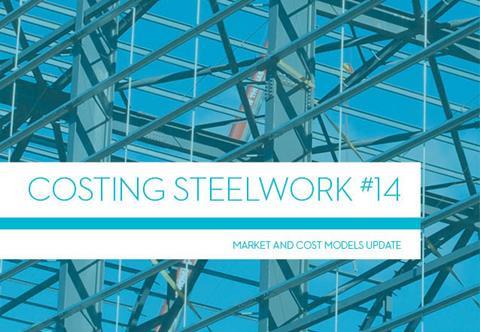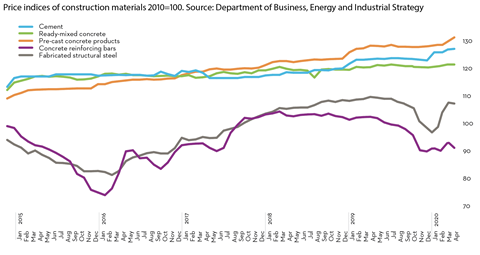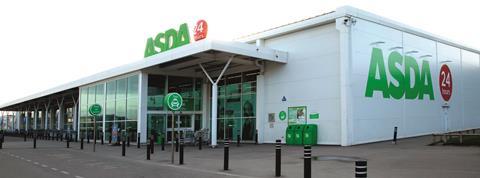Costing Steelwork is a series from Aecom, BCSA and Steel for Life that provides guidance on costing structural steelwork. This quarter provides a market update and updates the five cost models previously featured in Costing Steelwork

Large impacts to economies and domestic industry sectors are now evident. For how long they continue and the shape of the route out of this downturn is the principal economic question. Hopes for a V-shaped recovery are waning but not entirely gone. But the longer that economic and construction activity remains subdued, the more the realisation grows that a recovery will probably take a different shape.
UK business sentiment indicators plummeted at historic speed as lockdown descended across the UK. Early estimates and assessments of the UKŌĆÖs GDP annual growth rate dipped to -1.6% in Q1 of 2020. Further deterioration in this metric is expected for Q2 2020, once ONS data is available.
All materials classifications fell between Q4 2019 and Q1 2020. Labour cost inflation continued to move up to the point when the coronavirus lockdown was implemented
Initial data covering March saw construction new work output fall by 45% year-on-year, and by an almost similar value for the February to March monthly movement. All construction sub-sectors posted significant falls in output as lockdown and site closures hit hard. Positively, the sites and projects that were paused will restart, and this will eventually improve the output data. However, productivity will be significantly impaired by the social distancing required on site. This is likely to mean that prior output levels, if they are reached, are not seen until later in 2020.
AecomŌĆÖs composite index for building costs ŌĆō comprising materials and labour inputs ŌĆō rose by 1.1% over the year to Q1 2020. This is a notable slowing of the rate of input cost inflation, but is still an increase over the year. All materials classifications fell between Q4 2019 and Q1 2020. Labour cost inflation continued to move up to the point when the coronavirus lockdown was implemented. Weekly earnings for construction grew by 2.7% over the same period to Q1 2020. Similar to output data, labour-only wage inflation also started to see significant falls after the lockdown was implemented. Some reduction here is understandable, given that prevailing wage rates are a function of labour demand. Wage rates returning to pre-lockdown levels will be a closely watched indicator of how strongly industry activity is returning.
As site activity picks up again, a combination of restart demand, prevailing lockdown constraints and low supply inventories is expected to create a short-term spike in cost inflation over Q3 2020. Until distribution and supply channels return to some form of normal sequencing, some constraints will endure and impact the procurement of both domestically sourced and imported construction materials.
As site activity picks up again, a combination of restart demand, prevailing lockdown constraints and low supply inventories is expected to create a short-term spike in cost inflation over Q3 2020
Much of the construction supply chain is expected to experience increased financial stress during 2020. This is in addition to the already weak margin situation of the industry. Even a short lockdown period inevitably tests the financial resilience of many firms, but protracted disruption will lead to financial stress horizontally and vertically throughout the industry. Paused, delayed or deferred projects reduce cash flow. Balance sheet strength then becomes a determining factor in the survival of supply chain firms through this period of industry dislocation. Rising numbers of insolvencies are an expected consequence of this financial strain.
Tender price inflation was just over 2% in the 12 months to Q1 2020. Keener pricing was evident, although not uniformly across trades. UK regions showed variation in the rate of price change, most of which relates to a regionŌĆÖs position in the market cycle. Reduced demand for construction should, all things being equal, exert downward pressure on tender prices. For the purposes of developing a baseline forecast scenario, the current situation is deemed to be a pause to industry activity, albeit significant. If activity levels return to, or start to approach, pre-lockdown levels over Q3 2020, then pricing should see a resumption of inflationary but softer trends over the remainder of 2020. A capped forecast of 1% over the rest of 2020 is then the forecast outcome of this scenario.
Different scenarios see larger falls in tender prices, particularly where output remains depressed for an extended period, and where broader recessionary economic trends begin to influence the demand for construction services. This is a major emerging risk for the construction sector, now that some of the impacts from the lockdown are visible on economic activity and business confidence. It should be stressed that Brexit is an added complication to these scenarios and its specific impacts are excluded from the tender price forecasts for the time being. Nonetheless, a spectrum of disarrangement will occur, with no-deal Brexit bringing the largest amount of disruption to trading conditions and supply chains later this year.
Sourcing cost information
Cost information is generally derived from a variety of sources, including similar projects, market testing and benchmarking. Due to the mix of source information it is important to establish relevance, which is paramount when comparing buildings in size, form and complexity.
Figure 3 represents the costs associated with the structural framing of a building, with a BCIS location factor of 100 expressed as a cost/m┬▓ on GIFA. The range of costs represents variances in the key cost drivers. If a buildingŌĆÖs frame cost sits outside these ranges, this should act as a prompt to interrogate the design and determine the contributing factors.
The location of a project is a key factor in price determination, and indices are available to enable the adjustment of cost data across different regions. The variances in these indices, such as the BCIS location factors (figure 4), highlight the existence of different market conditions in different regions.
Figure 1: Material price trends

Figure 2: Tender price inflation, Aecom Tender Price Index, 2015=100
| Forecast* | |||||||
|---|---|---|---|---|---|---|---|
|
Quarter |
2017 |
2018 |
2019 |
2020 |
2021 |
2022 |
2023 |
|
1 |
110.9 |
113.2 |
117.9 |
120.4 |
ŌĆō |
ŌĆō |
ŌĆō |
|
2 |
111.3 |
113.6 |
118.3 |
120.4 |
ŌĆō |
ŌĆō |
ŌĆō |
|
3 |
112.2 |
115.4 |
119.3 |
ŌĆō |
ŌĆō |
ŌĆō |
ŌĆō |
|
4 |
112.6 |
117.3 |
120.0 |
ŌĆō |
ŌĆō |
ŌĆō |
ŌĆō |
* Meaningful forecasts are not possible at this time on the basis that the short- to medium-term impact of the covid-19 pandemic on the industry is unknown.
Figure 3: Indicative cost ranges based on gross internal floor area
| TYPE | Base index 100 (┬Ż/m2) | Notes |
|---|---|---|
|
Frames |
||
|
Steel frame to low-rise building |
102-124 |
Steelwork design based on 55kg/m2 |
|
Steel frame to high-rise building |
171-193 |
Steelwork design based on 90kg/m2 |
|
Complex steel frame |
193-228 |
Steelwork design based on 110kg/m2 |
|
Floors |
||
|
Composite floors, metal decking and lightweight concrete topping |
62-95 |
Two-way spanning deck, typical 3m span with concrete topping up to 150mm |
|
Precast concrete composite floor with concrete topping |
102-144 |
Hollowcore precast concrete planks with structural concrete topping spanning between primary steel beams |
|
Fire protection |
||
|
Fire protection to steel columns and beams (60 minutes resistance) |
15-20 |
Factory applied intumescent coating |
|
Fire protection to steel columns and beams (90 minutes resistance) |
17-29 |
Factory applied intumescent coating |
|
Portal frames |
||
|
Large-span single-storey building with low eaves (6-8m) |
75-98 |
Steelwork design based on 35kg/m2 |
|
Large-span single-storey building with high eaves (10-13m) |
86-119 |
Steelwork design based on 45kg/m2 |
Figure 4: BCIS location factors, as at Q4 2019
| Location | BCIS Index | Location | BCIS Index |
|---|---|---|---|
|
Central London |
128 |
Nottingham |
104 |
|
Manchester |
99 |
Glasgow |
93 |
|
Birmingham |
96 |
Newcastle |
92 |
|
Liverpool |
94 |
Cardiff |
95 |
|
Leeds |
93 |
Dublin |
97* |
*Aecom index
Steel For Life sponsors
Headline

Gold
Ficep UK Ltd, National Tube Stockholders and Cleveland Steel & Tubes, Peddinghaus Corporation, voestalpine Metsec plc, Wedge Group Galvanizing Ltd
Silver
Jack Tighe Ltd, Kaltenbach Ltd, Tata Steel, Trimble Solutions (UK) Ltd
Cost comparison updates
This quarterŌĆÖs Costing Steelwork provides an update of the five previously featured cost comparisons covering: offices, education, industrial, retail and mixed-use
These five projects were originally part of the Target Zero study conducted by a consortium of organisations including Tata Steel, Aecom, SCI, Cyril Sweett and the BCSA in 2010 to provide guidance on the design and construction of sustainable, low- and zero-carbon buildings in the UK. The cost models for these five projects have been reviewed and updated as part of the Costing Steelwork series. The latest cost models as of Q1 2020 are presented here.

Costing steelwork: offices update
Below is an update to the offices cost comparison originally published in the Costing Steelwork Offices feature in ║├╔½Ž╚╔·TV magazine in April 2017.
One Kingdom Street, London, key features
- 10 storeys, with two levels of basement
- Typical clear spans of 12m x 10.5m
- Three cores ŌĆō one main core with open atrium, scenic atrium bridges and lifts
- Plant at roof level
Cost comparison
Two structural options for the office building were assessed (as shown in figure 5):
- Base case ŌĆō a steel frame, comprising fabricated cellular steel beams supporting a lightweight concrete slab on a profiled steel deck
- Option 1 ŌĆō 350mm-thick post-tensioned concrete flat slab with a 650mm x 1,050mm perimeter beam.
The full building cost plans for each structural option have been reviewed and updated to provide current costs at Q2 2020. Movement has continued to be relatively static from Q1 2020. The costs, which include preliminaries, overheads, profit and a contingency, are summarised in figure 5.
The cost of the steel composite solution is 7% lower than that for the post-tensioned concrete flat slab alternative for the frame and upper floors, and 5% lower on a total building basis.
Figure 5: Key costs ┬Ż/m┬▓ (GIFA), for City of London office building
| Elements | Steel composite | Post-tensioned concrete flat slab |
|---|---|---|
|
Substructure |
89 |
95 |
|
Frame and upper floors |
442 |
476 |
|
Total building |
2,665 |
2,798 |
Costing steelwork: education update
Below is an update to the education cost comparison originally published in the Costing Steelwork Education feature in ║├╔½Ž╚╔·TV magazine in July 2017.
Christ the King Centre for Learning, Merseyside, key features
- Three storeys, with no basement levels
- Typical clear spans of 9m x 9m
- 591m2 sports hall (with glulam frame), 770m2 activity area and atrium
- Plant at roof level
Cost comparison
Three structural options for the building were assessed (as shown in figure 6), which include:
- Base case ŌĆō steel frame, 250mm hollowcore precast concrete planks with 75mm structural screed
- Option 1 ŌĆō in situ 350mm reinforced concrete flat slab with 400mm x 400mm columns
- Option 2 ŌĆō steel frame, 130mm concrete topping on structural metal deck.
The full building cost plans for each option have been updated to provide current costs at Q2 2020. The comparative costs highlight the importance of considering total building cost when selecting the structural frame material.
The concrete flat slab option has a marginally lower frame and floor cost compared with the steel composite option, but on a total-building basis, the steel composite option has a lower overall cost ┬Ż3,159/m2 against ┬Ż3,185/m2. This is because of lower substructure and roof costs, alongside lower preliminaries resulting from the shorter programme.
Figure 6: Key costs ┬Ż/m┬▓ (GIFA), for Merseyside secondary school
| Elements | Steel + precast hollow-core planks | In situ concrete flat slab | Steel composite |
|---|---|---|---|
|
Frame and upper floors |
294 |
254 |
267 |
|
Total building |
3,216 |
3,185 |
3,159 |
Costing steelwork: industrial update
Below is an update to the industrial cost comparison originally published in the Costing Steelwork Industrial feature in ║├╔½Ž╚╔·TV magazine in October 2017.
Distribution warehouse in ProLogis Park, Stoke-on-Trent, key features
- Warehouse: four-span, steel portal frame, with a net internal floor area of 34,000m2
- Office: 1,400m2, two-storey office wing with a braced steel frame with columns
Cost comparison
Three frame options were considered:
- Base option ŌĆō a steel portal frame with a simple roof solution
- Option 1 ŌĆō a hybrid option: precast concrete column and glulam beams with timber rafters
- Option 2 ŌĆō a steel portal frame with a northlight roof solution.
The full building cost plans for each option have been updated to provide costs at Q2 2020. The steel portal frame provides optimum build value at ┬Ż691/m2; glulam is least cost-efficient. This is primarily due to the cost premium for the structural members necessary to provide the required spans, which are otherwise efficiently catered for in the steelwork solution.
With a hybrid, the elements are from different suppliers, which raises the cost. The northlights option is directly comparable with the portal frame in relation to the warehouse and office frame. The variance is in the roof framing as the northlights need more. Other additional costs relate to the glazing of the northlights.
Figure 7: Key costs ┬Ż/m2 (GIFA), for Stoke-on-Trent distribution warehouse
| Elements | Steel portal frame | Glulam beams + purlins + concrete columns | Steel portal frame + north-lights |
|---|---|---|---|
|
Warehouse |
71 |
144 |
84 |
|
Office |
131 |
173 |
131 |
|
Total frame |
75 |
145 |
88 |
|
Total building |
691 |
774 |
743 |
Costing steelwork: retail update
Below is an update to the retail cost comparison originally published in the Costing Steelwork retail feature in ║├╔½Ž╚╔·TV magazine in January 2018.
Asda food store, Stockton-on-Tees,
key features
- Total floor area of 9,393m2
- Retail area based on 12m x 12m structural grid
Cost comparison
Three frame options were considered (as shown in figure 8) to establish the optimum solution for the building, as follows:
- Base option ŌĆō a steel portal frame on
CFA piles
- Option 1 ŌĆō glulam timber rafters and columns on CFA piles
- Option 2 ŌĆō a steel portal frame with a northlight roof solution on driven steel piles.
The full building cost plans for each option have been updated to provide costs at Q2 2020. The steel portal frame provides the optimum build value at ┬Ż2,629/m2, with the glulam option the least cost-efficient. The greater cost is due to the direct comparison of the steel frame solution against the glulam columns and beams/ rafters. A significant proportion of the building cost is in the M&E services and fit-out elements, which reduce the impact of the structural changes.
The northlights option is directly comparable with the portal frame in relation to the main supermarket ŌĆō the variance is in the roof framing as the northlights require more. Additional costs beyond the frame are related to the glazing of the northlights and the overall increase in relative roof area.
Figure 8: Key costs ┬Ż/m2 (GIFA), for Stockton-on-Tees food store
| Elements | Steel portal frame | Glulam timber rafters + columns | Steel portal frame + north-lights |
|---|---|---|---|
|
Structural unit cost |
145 |
177 |
163 |
|
Total building unit cost |
2,629 |
2,669 |
2,639 |
Costing steelwork: mixed-use update
Below is an update to the mixed-use cost comparison originally published in the Costing Steelwork mixed-use focus feature in ║├╔½Ž╚╔·TV magazine in April 2018.
Holiday Inn tower, MediaCityUK, Manchester
- 17-storey tower
- 7,153m2 of open-plan office space on five floors (floors two to six)
- 9,265m2 of hotel space on eight floors (floors eight to 15)
The gross internal floor area of the building is 18,625m2. The 67m-high building is rectilinear with approximate dimensions of 74m x 15.3m.
Cost comparison
Three frame options were considered to establish the optimum solution for the building:
- Base option ŌĆō steel frame with Slimdek floors
- Option 1 ŌĆō concrete flat slab
- Option 2 ŌĆō composite deck on cellular beams (offices) and UCs used as beams (hotel).
The full building cost plans for each option have been updated to provide costs at Q2 2020. The steel frame with composite deck continues to provide the optimum build value, with the overall building cost at ┬Ż2,600/m2.
Options 1 and 2 are arguably more typical for this building type. The base case structure is an unusual solution due to a decision to change the residential accommodation to office floors at a very late stage ŌĆō time constraints precluded redesign of the tower block, hence the original Slimdek design was constructed.
Figure 9: Key costs ┬Ż/m2 (GIFA), for hotel/office building in Manchester
| Elements | Steel frame with Slimdek | Concrete flat slab | Composite deck on cellular beams (offices) and UCs used as beams (hotel) |
|---|---|---|---|
|
Structural unit cost |
518 |
433 |
354 |
|
Total building unit cost |
2,809 |
2,705 |
2,600 |
This Costing Steelwork article produced by Patrick McNamara (director) and Michael Hubbard (associate) of Aecom is available at .
The data and rates contained in this article have been produced for comparative purposes only and should not be used or relied upon for any other purpose without further discussion with Aecom. Aecom does not owe a duty of care to the reader or accept responsibility for any reliance on the article contents.



























No comments yet